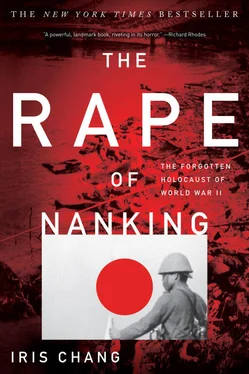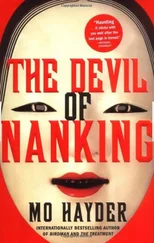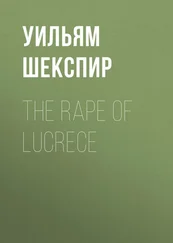Here is what we learn. The Japanese soldier was not simply hardened for battle in China; he was hardened for the task of murdering Chinese combatants and noncombatants alike. Indeed, various games and exercises were set up by the Japanese military to numb its men to the human instinct against killing people who are not attacking.
For example, on their way to the capital, Japanese soldiers were made to participate in killing competitions, which were avidly covered by the Japanese media like sporting events. The most notorious one appeared in the December 7 issue of the Japan Advertiser under the headline “Sub-Lieutenants in Race to Fell 100 Chinese Running Close Contest.”
Sub-Lieutenant Mukai Toshiaki and Sub-Lieutenant Noda Takeshi, both of the Katagiri unit at Kuyung, in a friendly contest to see which of them will first fell 100 Chinese in individual sword combat before the Japanese forces completely occupy Nanking, are well in the final phase of their race, running almost neck to neck. On Sunday [December 5]… the “score,” according to the Asahi, was: Sub-Lieutenant Mukai, 89, and Sub-Lieutenant Noda, 78.
A week later the paper reported that neither man could decide who had passed the 100 mark first, so they upped the goal to 150. “Mukai’s blade was slightly damaged in the competition,” the Japan Advertiser reported. “He explained that this was the result of cutting a Chinese in half, helmet and all. The contest was ‘fun’ he declared.”
Such atrocities were not unique to the Nanking area. Rather, they were typical of the desensitization exercises practiced by the Japanese across China during the entire war. The following testimony by a Japanese private named Tajima is not unusual:
One day Second Lieutenant Ono said to us, “You have never killed anyone yet, so today we shall have some killing practice. You must not consider the Chinese as a human being, but only as something of rather less value than a dog or cat. Be brave! Now, those who wish to volunteer for killing practice, step forward.”
No one moved. The lieutenant lost his temper.
“You cowards!” he shouted. “Not one of you is fit to call himself a Japanese soldier. So no one will volunteer? Well then, I’ll order you.” And he began to call out names, “Otani—Furukawa—Ueno—Tajima!” (My God—me too!)
I raised my bayoneted gun with trembling hands, and—directed by the lieutenant’s almost hysterical cursing—I walked slowly towards the terror-stricken Chinese standing beside the pit—the grave he had helped to dig. In my heart, I begged his pardon, and—with my eyes shut and the lieutenant’s curses in my ears—I plunged the bayonet into the petrified Chinese. When I opened my eyes again, he had slumped down into the pit. “Murderer! Criminal!” I called myself.
For new soldiers, horror was a natural impulse. One Japanese wartime memoir describes how a group of green Japanese recruits failed to conceal their shock when they witnessed seasoned soldiers torture a group of civilians to death. Their commander expected this reaction and wrote in his diary: “All new recruits are like this, but soon they will be doing the same things themselves.”
But new officers also required desensitization. A veteran officer named Tominaga Shozo recalled vividly his own transformation from innocent youth to killing machine. Tominaga had been a fresh second lieutenant from a military academy when assigned to the 232nd Regiment of the 39th Division from Hiroshima. When he was introduced to the men under his command, Tominaga was stunned. “They had evil eyes,” he remembered. “They weren’t human eyes, but the eyes of leopards or tigers.”
On the front Tominaga and other new candidate officers underwent intensive training to stiffen their endurance for war. In the program an instructor had pointed to a thin, emaciated Chinese in a detention center and told the officers: “These are the raw materials for your trial of courage.” Day after day the instructor taught them to how to cut off heads and bayonet living prisoners.
On the final day, we were taken out to the site of our trial. Twenty-four prisoners were squatting there with their hands tied behind their backs. They were blindfolded. A big hole had been dug—ten meters long, two meters wide, and more than three meters deep. The regimental commander, the battalion commanders, and the company commanders all took the seats arranged for them. Second Lieutenant Tanaka bowed to the regimental commander and reported, “We shall now begin.” He ordered a soldier on fatigue duty to haul one of the prisoners to the edge of the pit; the prisoner was kicked when he resisted. The soldiers finally dragged him over and forced him to his knees. Tanaka turned toward us and looked into each of our faces in turn. “Heads should be cut off like this,” he said, unsheathing his army sword. He scooped water from a bucket with a dipper, then poured it over both sides of the blade. Swishing off the water, he raised his sword in a long arc. Standing behind the prisoner, Tanaka steadied himself, legs spread apart, and cut off the man’s head with a shout, “Yo!” The head flew more than a meter away. Blood spurted up in two fountains from the body and sprayed into the hole.
The scene was so appalling that I felt I couldn’t breathe.
But gradually, Tominaga Shozo learned to kill. And as he grew more adept at it, he no longer felt that his men’s eyes were evil. For him, atrocities became routine, almost banal. Looking back on his experience, he wrote: “We made them like this. Good sons, good daddies, good elder brothers at home were brought to the front to kill each other. Human beings turned into murdering demons. Everyone became a demon within three months.”
Some Japanese soldiers admitted it was easy for them to kill because they had been taught that next to the emperor, all individual life—even their own—was valueless. Azuma Shiro, the Japanese soldier who witnessed a series of atrocities in Nanking, made an excellent point about his comrades’ behavior in his letter to me. During his two years of military training in the 20th Infantry Regiment of Kyoto-fu Fukuchi-yama, he was taught that “loyalty is heavier than a mountain, and our life is lighter than a feather.” He recalled that the highest honor a soldier could achieve during war was to come back dead: to die for the emperor was the greatest glory, to be caught alive by the enemy the greatest shame. “If my life was not important,” Azuma wrote to me, “an enemy’s life became inevitably much less important…. This philosophy led us to look down on the enemy and eventually to the mass murder and ill treatment of the captives.”
In interview after interview, Japanese veterans from the Nanking massacre reported honestly that they experienced a complete lack of remorse or sense of wrongdoing, even when torturing helpless civilians. Nagatomi Hakudo spoke candidly about his emotions in the fallen capital:
I remember being driven in a truck along a path that had been cleared through piles of thousands and thousands of slaughtered bodies. Wild dogs were gnawing at the dead flesh as we stopped and pulled a group of Chinese prisoners out of the back. Then the Japanese officer proposed a test of my courage. He unsheathed his sword, spat on it, and with a sudden mighty swing he brought it down on the neck of a Chinese boy cowering before us. The head was cut clean off and tumbled away on the group as the body slumped forward, blood spurting in two great gushing fountains from the neck. The officer suggested I take the head home as a souvenir. I remember smiling proudly as I took his sword and began killing people.
After almost sixty years of soul-searching, Nagatomi is a changed man. A doctor in Japan, he has built a shrine of remorse in his waiting room. Patients can watch videotapes of his trial in Nanking and a full confession of his crimes. The gentle and hospitable demeanor of the doctor belies the horror of his past, making it almost impossible for one to imagine that he had once been a ruthless murderer.
Читать дальше











